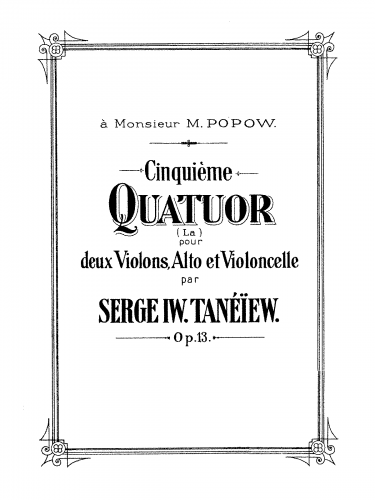Obscure Music Monday: Taneyev's String Quartet No. 5
Many talented Russian composers have slid from the memories of the rest of the world over the past century, which leaves us with a lot of gems to discover in their works. Today we look at one of those works that has faded from the repertoire - Sergey Taneyev’s String Quartet No. 5, Op. 13.
Taneyev was a composition student of Tchaikovsky’s at the Moscow Conservatory, as well as a piano student of Edward Langer, who created virtuosic arrangements of many of Tchaikovsky’s works for multiple piano players. While Taneyev came from an era of Russian nationalism in music, he rejected this emotional and, at times, bombastic style for a more technical language more in line with European composers of the time. His music shows the influence he had on future generations of Russians, including students Rachamaninoff and Scriabin.
The quartet opens with a simple theme based on a syncopated line that forms a rhythmic basis for much of the development to follow. Throughout the movement, Taneyev shows off his mastery of voicing and counterpoint, with beautiful harmonic and melodic lines appearing in all of the instruments. As he builds up this melodic idea with the accompaniment of a repeated sixteenth note figure featuring a drop of a second, Taneyev moves to a second theme marked scherzando, being introduced in the viola, before being picked up by the first violin. After building us up to a fortissimo climax in the recapitulation, Taneyev leaves us in the first movement with an idea voiced in the upper registers of the instruments, fading to a sustained, but barely audible, A Major chord.
A lush slow movement follows, opening with a violin melody accompanied by a rising chromatic figure in the viola and cello that becomes an idea that Taneyev works with throughout the movement, with an eighth note bass figure, and a slow triplet rising figure as well. After significant development of these ideas, Taneyev builds to a forte, which quickly descends through a chromatic line in the viola, ending again on a soft chord, this time F Major.
As we move into the third movement, we experience a lively scherzo theme that uses a short motivic idea which Taneyev develops significantly, showing the influence of Tchaikovsky as he rapidly moves the motive through many different key placements, before taking the same idea into the trio with a more subdued approach.
Taneyev closes with a final movement that is more restrained than many of the Russian composers to come before him, but he presents his ideas in a refined manner that brings the work to a wonderful close. The fourth movement includes a number of small climaxes and a wonderful legato second theme. After a grand pause, Taneyev takes us to a faster prestissimo tempo, with almost fugal entries by the instruments presenting the same motivic material capped by a sudden crescendo from piano to fortissimo that suddenly drops to a short motive that opened the first movement repeated, piano, by pairs of the instruments and two pianissimo pizzicato chords that end the work.
Two recordings are available today as interest in Taneyev’s works has started to rebuild, both as part of a complete set of recordings of Taneyev’s string quartets:
Carpe Diem String Quartet
Taneyev String Quartet


